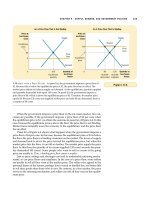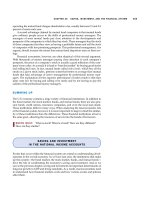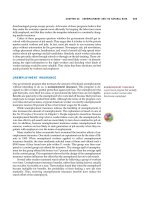Tài liệu COMMUNITY-BASED MANAGEMENT OF SEVERE ACUTE MALNUTRITION doc
Bạn đang xem bản rút gọn của tài liệu. Xem và tải ngay bản đầy đủ của tài liệu tại đây (382.88 KB, 8 trang )
COMMUNITY-BASED MANAGEMENT OF
SEVERE ACUTE MALNUTRITION
A Joint Statement by the World Health Organization, the World Food Programme, the United Nations
System Standing Committee on Nutrition and the United Nations Children’s Fund
40454Eng_Cov.indd 240454Eng_Cov.indd 2 4/12/07 6:31:35 PM4/12/07 6:31:35 PM
Process CyanProcess CyanProcess MagentaProcess MagentaProcess YellowProcess YellowProcess BlackProcess Black
S
evere acute malnutrition remains a major killer of children under five years of age.
Until recently, treatment has been restricted to facility-based approaches, greatly
limiting its coverage and impact. New evidence suggests, however, that large
numbers of children with severe acute malnutrition can be treated in their communities
without being admitted to a health facility or a therapeutic feeding centre.
The community-based approach involves timely detection of severe acute malnutrition
in the community and provision of treatment for those without medical complications
with ready-to-use therapeutic foods or other nutrient-dense foods at home. If properly
combined with a facility-based approach for those malnourished children with medical
complications and implemented on a large scale, community-based management of
severe acute malnutrition could prevent the deaths of hundreds of thousands of children.
Nearly 20 million children under five
suffer from severe acute malnutrition
Severe acute malnutrition is defined by a very low
weight for height (below -3 z scores
1
of the median
WHO growth standards), by visible severe wasting,
or by the presence of nutritional oedema. In
children aged 6–59 months, an arm circumference
less than 110 mm is also indicative of severe acute
malnutrition. Globally, it is estimated that there are
nearly 20 million children who are severely acutely
malnourished.
2
Most of them live in south Asia and
in sub-Saharan Africa.
Severe acute malnutrition contributes
to 1 million child deaths every year
Using existing studies of case fatality rates in
several countries, WHO has extrapolated mortality
rates of children suffering from severe acute
malnutrition. The mortality rates listed in the table
at right reflect a 5–20 times higher risk of death
compared to well-nourished children. Severe acute
malnutrition can be a direct cause of child death,
or it can act as an indirect cause by dramatically
increasing the case fatality rate in children suffering
from such common childhood illnesses as diarrhoea
and pneumonia. Current estimates suggest that
about 1 million children die every year from severe
acute malnutrition.
3
The large burden of child mortality due to severe
acute malnutrition remains largely absent
from the international health agenda, and few
countries, even in high prevalence areas, have
specific national policies aimed at addressing it
comprehensively. With the addition of community-
based management to the existing facility-based
approach, much more can now be done to address
this important cause of child mortality.
Severe acute malnutrition in children
can be identified in the community
before the onset of complications
Community health workers or volunteers can
easily identify the children affected by severe
acute malnutrition using simple coloured plastic
2
Mortality of children with severe acute
malnutrition observed in longitudinal studies
Country Mortality rate
Congo, Democratic Republic of the 21%
Bangladesh 20%
Senegal 20%
Uganda 12%
Yemen 10%
Note: For studies of less than 12 months, rate was adjusted for duration of follow-up.
Sources: Congo, Democratic Republic of the: Van Den Broeck, J., R. Eeckels and J.
Vuylsteke, ‘Influence of nutritional status on child mortality in rural Zaire’, The Lancet,
vol. 341, no. 8859, 12 June 1993, pp. 1491–1495; Bangladesh: Briend, A., B. Wojtyniak
and M.G. Rowland, ‘Arm circumference and other factors in children at high risk of
death in rural Bangladesh’, The Lancet, vol. 2, no. 8561, 1987, pp. 725–728; Senegal:
Garenne, Michel, et al., ‘Risques de décès associés à différents états nutritionnels
chez l’enfant d’âge pré scolaire’, Etude réalisée à Niakhar (Sénégal), 1983-1983,
Paris: CEPED, 2000; Uganda: Vella, V., et al., ‘Determinants of child nutrition and
mortality in north-west Uganda’, Bulletin of the World Health Organization, vol. 70,
no. 5, 17 September 1992, pp. 637–643; Yemen: Bagenholm, G.C., and A.A. Nasher,
‘Mortality among children in rural areas of the People’s Democratic Republic of
Yemen’, Annals of Tropical Paediatrics, vol. 9, no. 2, June 1989, pp. 75–81.
1
A ‘z score’ is the number of standard deviations below or above the reference mean
or median value.
2,3
WHO is currently estimating the global number of children suffering from severe
acute malnutrition and the number of deaths associated with the condition.
strips that are designed to measure mid-upper
arm circumference (MUAC). In children aged 6–59
months, a MUAC less than 110 mm indicates severe
acute malnutrition, which requires urgent treatment.
Community health workers can also be trained to
recognize nutritional oedema of the feet, another
sign of this condition.
Once children are identified as suffering from severe
acute malnutrition, they need to be seen by a health
worker who has the skills to fully assess them
following the Integrated Management of Childhood
Illness (IMCI) approach. The health worker should
then determine whether they can be treated in the
community with regular visits to the health centre,
or whether referral to in-patient care is required.
Early detection, coupled with decentralized
treatment, makes it possible to start management
of severe acute malnutrition before the onset of life-
threatening complications.
Uncomplicated forms of severe acute
malnutrition should be treated in the
community
In many poor countries, the majority of children
who have severe acute malnutrition are never
brought to health facilities. In these cases, only
an approach with a strong community component
can provide them with the appropriate care.
Evidence shows that about 80 per cent of children
with severe acute malnutrition who have been
identified through active case finding, or through
sensitizing and mobilizing communities to access
decentralized services themselves, can be treated
at home.
The treatment is to feed children a ready-to-use
therapeutic food (RUTF) until they have gained
adequate weight. In some settings it may be
possible to construct an appropriate therapeutic diet
using locally available nutrient-dense foods with
added micronutrient supplements. However, this
approach requires very careful monitoring because
nutrient adequacy is hard to achieve.
In addition to the provision of RUTF, children need
to receive a short course of basic oral medication to
treat infections. Follow-up, including the provision
of the next supply of RUTF, should be done weekly
or every two weeks by a skilled health worker in a
nearby clinic or in the community.
Community-based management of
severe acute malnutrition can have a
major public health impact
With modern treatment regimens and improved
access to treatment, case-fatality rates can be
as low as 5 per cent, both in the community
and in health-care facilities. Community-based
management of severe acute malnutrition was
introduced in emergency situations. It resulted in a
dramatic increase of the programme coverage and,
consequently, of the number of children who were
treated successfully – yielding a low case-fatality rate.
The same approach can be used in non-emergency
situations with a high prevalence of severe acute
malnutrition, preventing hundreds of thousands of
child deaths when applied at scale.
Ready-to-use therapeutic foods
Children with severe acute malnutrition need safe,
palatable foods with a high energy content and
adequate amounts of vitamins and minerals. RUTF
3
© Marko Kerac 2004
are soft or crushable foods that can be consumed
easily by children from the age of six months
without adding water. RUTF have a similar nutrient
composition to F100, which is the therapeutic diet
used in hospital settings. But unlike F100, RUTF are
not water-based, meaning that bacteria cannot grow
in them. Therefore these foods can be used safely at
home without refrigeration and even in areas where
hygiene conditions are not optimal.
When there are no medical complications, a
malnourished child with appetite, if aged six months
or more, can be given a standard dose of RUTF
adjusted to their weight. Guided by appetite, children
may consume the food at home, with minimal
supervision, directly from a container, at any time of
the day or night. Because RUTF do not contain water,
children should also be offered safe drinking water to
drink at will.
The technology to produce RUTF is simple and can
be transferred to any country with minimal industrial
infrastructure. RUTF cost about US$3 per kilogram
when locally produced. A child being treated for
severe acute malnutrition will need 10–15 kg of
RUTF, given over a period of six to eight weeks.
Community-based management
of severe acute malnutrition in the
context of high HIV prevalence
The majority of HIV-positive children suffering
from severe acute malnutrition will benefit from
community-based treatment with RUTF. However,
experience shows that rates of weight gain and
recovery are lower among these children than
among those who are HIV-negative, and their case-
fatality rate is higher. The lower weight gain is
probably related to a higher incidence of infections
in children who are HIV-positive.
Given the overlap in presentation of severe acute
malnutrition and HIV infection and AIDS in children,
especially in poor areas, strong links between
community-based management of severe acute
malnutrition and AIDS programmes are essential.
Voluntary counselling and testing should be
available for children with severe acute malnutrition
and for their mothers. If diagnosed as HIV-positive,
they should qualify for cotrimoxazole prophylaxis
to prevent the risk of contracting Pneumocystis
pneumonia and other infections, and for
antiretroviral therapy when indicated. At the same
time, children who are known to be HIV-positive
and who develop severe acute malnutrition should
have access to therapeutic feeding to improve their
nutritional status.
Ending severe acute malnutrition
Prevention first…
Investing in prevention is critical. Preventive
interventions can include: improving access to
high-quality foods and to health care; improving
nutrition and health knowledge and practices;
effectively promoting exclusive breastfeeding for the
first six months of a child’s life where appropriate;
promoting improved complementary feeding
practices for all children aged 6–24 months — with
a focus on ensuring access to age-appropriate
complementary foods (where possible using locally
available foods); and improving water and sanitation
systems and hygiene practices to protect children
against communicable diseases.
…but treatment is urgently needed for those
who are malnourished
Severe acute malnutrition occurs mainly in families
that have limited access to nutritious food and are
living in unhygienic conditions, which increase
the risk of repeated infections. Thus, preventive
programmes have an immense job to do in the
© Valid International
4
context of poverty, and in the meantime children
who already are suffering from severe acute
malnutrition need treatment.
In May 2002, the Fifty-Fifth World Health Assembly
endorsed the Global Strategy for Infant and
Young Child Feeding, which recommends actively
searching for malnourished infants and young
children so they can be identified and treated. The
development of the community-based approach
for the management of severe acute malnutrition
should provide a new impetus for putting this
recommendation into practice. It is urgent,
therefore, that this approach, along with preventive
action, be added to the list of cost-effective
interventions to reduce child mortality.
What countries can do
Countries can save children’s lives by:
Adopting and promoting national policies and
programmes that:
Ensure that national protocols for the
management of severe acute malnutrition
(based, if necessary, on the provision of
RUTF) have a strong community-based
component that complements facility-based
activities.
Achieve high coverage of interventions
aimed at identifying and treating children
in all parts of the country and at all times
of the year through effective community
mobilization and active case finding.
Provide training and support for community
health workers to identify children with
severe acute malnutrition who need urgent
treatment and to recognize those children
with associated complications who need
urgent referral.
Establish adequate referral arrangements for
children suffering from complicated forms
of severe acute malnutrition so they can
receive adequate inpatient treatment.
Provide training for improved management
of severe acute malnutrition at all levels,
involving an integrated approach that
includes community- and facility-based
components.
1.
•
•
•
•
•
Providing the resources needed for management
of severe acute malnutrition, including:
Making RUTF available to families of
children with severe acute malnutrition
through a network of community health
workers or community-level health facilities,
preferably by encouraging the local food
industry to produce RUTF in settings where
families do not have access to appropriate
local foods.
Ensuring funding to provide free treatment
of severe acute malnutrition because affected
families are often among the poorest.
Integrating the management of severe acute
malnutrition with other health activities, such as:
Preventive nutrition initiatives, including
promotion of breastfeeding and appropriate
complementary feeding, and provision
of relevant information, education and
communication (IEC) materials.
Activities related to the Integrated
Management of Childhood Illness at first-
level health facilities and at the referral
level, and initiating such activities where
they do not exist.
WHO, WFP, SCN, UNICEF and other partners
will support these actions by:
Mobilizing resources to support implementation
of these recommendations.
Facilitating the local production or procurement
of RUTF for countries with a high prevalence of
severe acute malnutrition in communities where
access to nutrient-dense foods is limited.
Supporting the development and evaluation of
nutrition rehabilitation protocols based on local
foods in countries where poor families have
access to nutrient-dense foods.
Working with governments and the private
sector, including non-governmental
organizations, to rapidly disseminate these
recommendations and build capacity for their
implementation.
Conducting operations research to refine
protocols of community-based management of
severe acute malnutrition.
Jointly implementing expanded community-
based programmes to combat severe acute
malnutrition in major humanitarian emergency
situations.
2.
•
•
3.
•
•
•
•
•
•
•
•
5
6
Technical annex
Ready-to-use therapeutic foods
Ready-to-use therapeutic foods (RUTF) are high-
energy, fortified, ready-to-eat foods suitable for the
treatment of children with severe acute malnutrition.
These foods should be soft or crushable and should
be easy for young children to eat without any
preparation. At least half of the proteins contained in
the foods should come from milk products.
Nutritional composition
Moisture content 2.5% maximum
Energy 520–550 Kcal/100 g
Proteins 10%–12% total energy
Lipids 45%–60% total energy
Sodium 290 mg/100 g maximum
Potassium 1,110–1,400 mg/100 g
Calcium 300–600 mg/100 g
Phosphorus
(excluding phytate) 300–600 mg/100 g
Magnesium 80–140 mg/100 g
Iron 10–14 mg/100 g
Zinc 11–14 mg/100 g
Copper 1.4–1.8 mg/100 g
Selenium 20–40 µg
Iodine 70–140 µg/100 g
Vitamin A 0.8–1.1 mg/100 g
Vitamin D 15–20 µg/100 g
Vitamin E 20 mg/100 g minimum
Vitamin K 15–30 µg/100 g
Vitamin B1 0.5 mg/100 g minimum
Vitamin B2 1.6 mg/100 g minimum
Vitamin C 50 mg/100 g minimum
Vitamin B6 0.6 mg/100 g minimum
Vitamin B12 1.6 µg/100 g minimum
Folic acid 200 µg/100 g minimum
Niacin 5 mg/100 g minimum
Pantothenic acid 3 mg/100 g minimum
Biotin 60 µg/100 g minimum
n-6 fatty acids 3%–10% of total energy
n-3 fatty acids 0.3%–2.5% of total energy
Note: Although RUTF contain iron, F100 does not. The composition of F100 can be found
in Management of Severe Malnutrition: A manual for physicians and other senior health
workers, World Health Organization, Geneva, 1999 (available online at
< />
Safety: The food should be free from objectionable
matter. It must not contain any substance
originating from microorganisms or any other
poisonous or deleterious substances, including anti-
nutritional factors, heavy metals or pesticides in
amounts that may represent a hazard to health.
Maximum toxin levels
Aflatoxin level 5 ppb maximum
Microorganism content 10,000/g maximum
Coliform test negative in 1 g
Clostridium perfringens negative in 1 g
Yeast maximum 10 in 1 g
Moulds maximum 50 in 1 g
Pathogenic Staphylococci negative in 1 g
Salmonella negative in 125 g
Listeria negative in 25 g
The product should comply with the Recommended
International Code of Hygienic Practice for Foods
for Infants and Children of the Codex Alimentarius
Standard CAC/RCP 21-1979 (available at
< />standards/297/CXP_021e.pdf>). All added mineral
salts and vitamins should be on the Advisory List
of Mineral Salts and Vitamin Compounds for Use
in Foods for Infants and Children of the Codex
Alimentarius Standard CAC/GL 10-1979 (available
at < />standards/300/CXG_010e.pdf>).
The added minerals should be water-soluble
and should not form insoluble components
when mixed together. The food should have a
mineral composition that will not alter the acid
base metabolism of children with severe acute
malnutrition. In particular, it should have a
moderate positive non-metabolizable base sufficient
to eliminate the risk of metabolic acidosis. The
non-metabolizable base can be approximated by the
formula: estimated absorbed millimoles (sodium +
potassium + calcium + magnesium) - (phosphorus
+ chloride). The mineral mix recommended for
F100 by WHO is an example of a mineral mix with a
suitable positive non-metabolizable base.
Information on producing RUTF locally is available
at < />New_Publications/NUTRITION/CBSM/tbp_4.pdf>.
References
Ciliberto, Michael A., et al., ‘Comparison of home-based therapy
with ready-to-use therapeutic food with standard therapy in the
treatment of malnourished Malawian children: A controlled,
clinical effectiveness trial’, The American Journal of Clinical
Nutrition, vol. 81, no. 4, 2005, pp. 864–870.
Collins, Steve, ‘Changing the way we address severe malnutrition
during famine’, The Lancet, vol. 358, 11 August 2001, pp. 498–501.
Collins, Steve, and Kate Sadler, ‘Outpatient care for severely
malnourished children in emergency relief programmes: A
retrospective cohort study’, The Lancet, vol. 360, 7 December
2002, pp. 1824–1830.
Collins, Steve, et al., ‘Management of severe acute malnutrition
in children’, The Lancet, vol. 368, no. 9551, 2 December 2006,
pp. 1992–2000.
Diop, El Hadji Issakha, et al., ‘Comparison of the efficacy of a
solid ready-to-use food and a liquid, milk-based diet for the
rehabilitation of severely malnourished children: A randomized
trial’, The American Journal of Clinical Nutrition, vol. 78, no. 2,
August 2003, pp. 302–307.
Gross, Rainer, and Patrick Webb, ‘Wasting time for wasted
children: Severe child undernutrition must be resolved in non-
emergency settings’, The Lancet, vol. 367, no. 9517, 8 April 2006,
pp. 1209–1211.
Manary, Mark J., et al., ‘Home based therapy for severe
malnutrition with ready-to-use food’, Archives of Disease in
Childhood, vol. 89, June 2004, pp. 557–561.
Navarro-Colorado, Carlos, and Stéphanie Laquière, ‘Clinical trial
of BP100 vs F100 milk for rehabilitation of severe malnutrition’,
Field Exchange, vol. 24, March 2005, pp. 22–24, <http://www.
ennonline.net/fex/24/Fex24.pdf>, accessed January 2007.
Prudhon, Claudine, et al., 'WHO, UNICEF, and SCN Informal
Consultation on Community-Based Management of Severe
Malnutrition in Children', SCN Nutrition Policy Paper No. 21,
Food and Nutrition Bulletin, vol. 27, no. 3 (supplement), 2006,
available at < />publications/NUTRITION/CBSM.htm>, accessed January 2007.
Sandige, H., et al., ‘Home-based treatment of malnourished
Malawian children with locally produced or imported ready-to-
use food’, Journal of Paediatric Gastroenterology and Nutrition,
vol. 39, no. 2, August 2004, pp. 141–146.
World Health Organization and UNICEF, Global Strategy for Infant
and Young Child Feeding, WHO, Geneva, 2003, <http://www.
who.int/nutrition/publications/gs_infant_feeding_text_eng.pdf>,
accessed January 2007.
World Health Organization, Management of Severe Malnutrition:
A manual for physicians and other senior health workers, WHO,
Geneva, 1999, < />manage_severe_malnutrition_eng.pdf>, accessed January 2007.
7
May 2007
© World Health Organization/World Food Programme/United
Nations System Standing Committee on Nutrition/The United
Nations Children’s Fund, 2007
This document may be freely reviewed, abstracted, reproduced
and translated, but it cannot be sold or used for commercial
purposes.
ISBN: 978-92-806-4147-9
Copies of this statement and further information may be
requested from:
Cover photo: © UNICEF/HQ04-0924/Shehzad Noorani
World Health Organization
Department of Child and Adolescent
Health and Development
Department of Nutrition for Health and
Development
20 Avenue Appia
1121 Geneva 27
Switzerland
Tel: +41 22 791 14 47
Email: or
www.who.int
World Food Programme
Nutrition Service
Policy, Strategy and Programme
Support Division
Via Cesare Giulio Viola 68/70
Parco de Medici
00148 Rome
Italy
Tel: +39 06 6513 2214
Fax: +39 06 6513 3174
Email:
www.wfp.org
United Nations System
Standing Committee on Nutrition
c/o World Health Organization
20 Avenue Appia
CH 1211 Geneva 27
Switzerland
Tel: +41 22 791 04 56
Fax: +41 22 798 88 91
Email:
www.unsystem.org/scn
United Nations Children’s Fund
Nutrition Section
3 United Nations Plaza
New York, NY 10017
USA
Tel: +1 212 326 7000
Fax: +1 212 735 4405
Email:
www.unicef.org
United Nations System
Standing Committee on Nutrition
40454Eng_Cov.indd 340454Eng_Cov.indd 3 4/12/07 6:33:44 PM4/12/07 6:33:44 PM
Process CyanProcess CyanProcess MagentaProcess MagentaProcess YellowProcess YellowProcess BlackProcess Black









